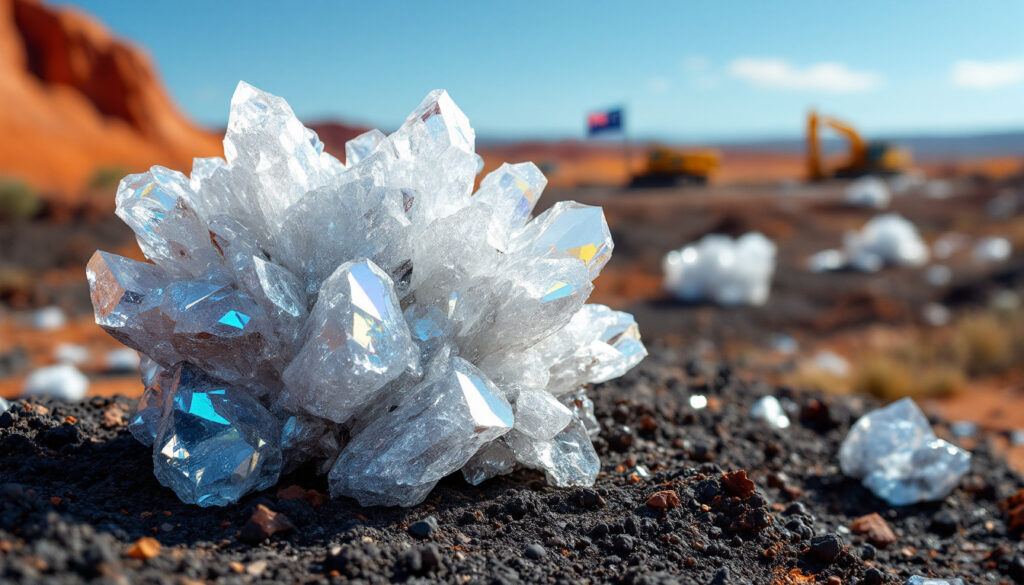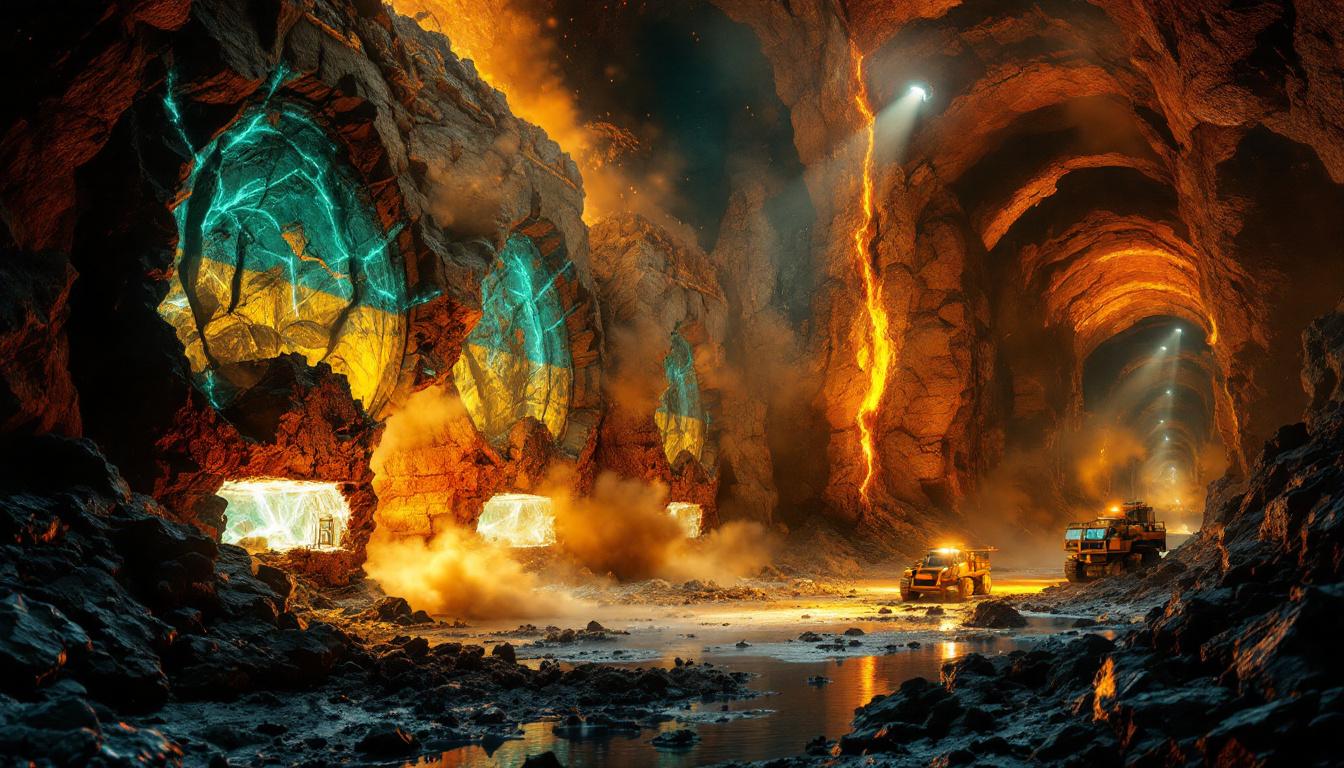How Significant is the Rosewood Heavy Mineral Sands Discovery?
The Rosewood Heavy Mineral Sands (HMS) discovery at Petratherm's (ASX:PTR) Muckanippie project in South Australia represents one of Australia's most promising titanium finds in recent years. What makes this discovery particularly noteworthy is its exceptional combination of grade, continuity, and favorable processing characteristics.
The discovery features a continuous high-grade mineralization zone extending over 3.6km north-south that remains open for further expansion. Recent drilling has confirmed the presence of shallow deposits, typically beginning at depths of just 6-10 meters below surface, making them ideal for cost-effective free-digging extraction methods.
Perhaps most impressive is the mineral composition, with laboratory analysis confirming an exceptionally high valuable mineral content exceeding 95% on average—significantly higher than typical HMS deposits which often contain 70-85% valuable heavy minerals. This mineral assemblage is primarily composed of titanium dioxide minerals, particularly rutile and leucoxene, which command premium prices in global markets.
When compared to established Australian HMS projects, Rosewood's preliminary grades stand out dramatically:
| Project | Average Grade (%HM) | Valuable Mineral Content | Current Status |
|---|---|---|---|
| Rosewood | 11-17% (up to 36.4% in zones) | >95% | Exploration |
| Eneabba (Iluka) | 3-8% | ~75% | Production |
| Coburn (Strandline) | 6.1% | 82% | Development |
This exceptional grade profile has attracted significant investor attention, with Petratherm's share price responding positively to ongoing exploration success. Following the latest announcement in May 2025, PTR shares jumped 27.8% to reach a daily high of 34.5c before settling at 29.5c at market close.
"These initial results confirm high-grade continuity across a substantial area, demonstrating the potential future commercial viability of the Rosewood project," noted Peter Reid, CEO of Petratherm.
What Do the Latest Drilling Results Reveal About Rosewood?
Expanded Strike Length and Higher Grades
The most recent aircore drilling program has substantially enhanced the Rosewood discovery profile, extending the strike length by an additional 1.6km northward through a systematic 73-hole program. More impressively, these new holes have revealed higher grades than previously intersected, including several standout intercepts:
- 26m at 17.2% heavy minerals from 7m depth (including 6m at 36.4% HM)
- 32m at 11.1% HM from 10m depth (including 3m at 22.7% HM)
- 15m at 11.5% HM from 6m depth (including 5m at 20.9% HM)
Importantly, the northernmost hole drilled to date returned 8m at 13.1% HM from just 6m depth, indicating the mineralization remains entirely open to the north—suggesting significant potential for further resource expansion.
Confirmation of Deposit Quality
These latest drilling results represent the best found at the project to date, validating several key aspects of the Rosewood discovery:
- Verified high-grade continuity across broader spacing than initial drilling
- Confirmed significant thickness of mineralization (averaging 15-30m)
- Demonstrated consistent titanium-dominant mineral assemblage
- Established the shallow, free-digging nature of the deposit throughout
Aircore drilling has proven particularly effective for evaluating these unconsolidated sands, providing cost-effective sample recovery with minimal environmental disturbance. The consistent results across varied drilling program types (200-400m) suggests excellent grade continuity, which is favorable for potential future mining operations.
How Was the Rosewood Discovery Made?
Discovery Timeline and Methodology
The Rosewood HMS discovery follows a methodical exploration pathway that began with surface reconnaissance and built upon historical data in the region:
| Date | Milestone |
|---|---|
| September 2024 | Initial discovery through outcrop sampling revealing 10-50% titanium dioxide content |
| Late 2024 | Re-assaying and re-logging of historical, wide-spaced drilling confirmed HMS presence |
| Early 2025 | Follow-up targeted drilling identified encouraging HM intersections over 15km² |
| May 2025 | Latest drilling extended strike length by 1.6km with higher grades than previously encountered |
The discovery process represents a textbook example of effective mineral exploration methodology:
- Initial recognition: Field geologists identified titanium-rich outcrops during regional reconnaissance
- Historical data review: Strategic re-examination of previously overlooked data from drilling conducted for other commodities (originally spaced at approximately 800m intervals)
- Concept validation: Initial targeted drilling to test the heavy mineral sand hypothesis
- Systematic delineation: Step-out drilling to define the extent and continuity of mineralization
This approach highlights the value of revisiting historical exploration data with fresh perspectives and modern analytical techniques—a strategy that continues to yield new discoveries in mature exploration trends in Australia.
What Makes the Rosewood Deposit Economically Attractive?
Processing Advantages and Mineral Composition
Several characteristics of the Rosewood HMS deposit contribute to its potential economic viability:
- Extraction simplicity: The shallow mineralization (typically starting at 6-10m depth) is amenable to free-digging methods, eliminating the need for blasting and reducing capital and operating costs
- Processing efficiency: Initial testing suggests compatibility with standard wet concentration techniques typical of HMS operations, which typically achieve 85-92% mineral recovery rates
- Premium mineral suite: The predominance of titanium dioxide minerals with minimal slimes (<5%) and low oversize material simplifies processing requirements
- High in-situ value: With >95% valuable heavy mineral content and titanium dioxide prices currently around US$2,800/t, the deposit carries substantial in-situ value per tonne
A key advantage of Rosewood compared to many international HMS deposits is the virtual absence of overburden, unlike many African deposits which require significant pre-stripping. This factor, combined with Australia's stable mining jurisdiction, potentially positions Rosewood as a globally competitive project.
"Our upcoming bulk sample testwork will be a key milestone and will go a long way to demonstrating the potential future commercial viability of the project," explained Peter Reid, CEO of Petratherm. "This work will inform separation processing requirements and allow us to produce initial heavy mineral sample products."
Industry analysts estimate typical operating costs for Australian HMS operations in the range of A$50-80 per tonne, with actual costs heavily dependent on strip ratio, mineral assemblage, and processing requirements. The favorable characteristics of Rosewood suggest it could potentially operate in the lower portion of this cost range.
Where is the Rosewood Discovery Located?
Project Location and Ownership Structure
The Rosewood HMS discovery is situated within the broader Muckanippie project in South Australia, approximately 200km from Port Bonython via the Eyre Highway. The project area encompasses several exploration licenses with varying ownership structures:
- Portions within 100% Petratherm-owned tenure
- EL 6715 under joint venture with Narryer Metals (ASX:NYM)
- EL 6873 under joint venture with G4 Metals
The project falls within the SA Geomap 1:250,000 Sheet SH53-13 area, a region historically explored primarily for copper, gold, and uranium, with limited previous attention to heavy mineral potential.
Geological Setting and Broader Potential
The mineral sands at Rosewood are associated with the weathering of the Muckanippie Suite, a major intrusive complex within the Gawler Craton. This geological environment has been recognized as highly prospective for critical minerals, with the potential for:
- Platinum group elements in the primary igneous rocks
- Vanadium enrichment in certain horizons
- Multiple titanium-rich zones beyond the current discovery area
The paleochannel system hosting the HMS deposit appears to be part of a more extensive drainage network, suggesting potential for additional discoveries in parallel or tributary channels. The South Australian GSSA database indicates similar geological settings extend throughout the region, enhancing exploration upside.
How Does the Rosewood Discovery Compare to Other HMS Projects?
The Rosewood heavy mineral sands discovery exhibits several distinguishing characteristics when compared to other established or developing heavy mineral sands projects in Australia and globally:
| Feature | Rosewood | Typical HMS Projects | Advantage |
|---|---|---|---|
| Grade | 11-17% HM (up to 36.4%) | 2-8% HM | Substantially higher grade |
| Valuable mineral content | >95% | 70-85% | Reduced waste processing |
| Depth | 6-10m to mineralization | Often 15-30m | Lower stripping costs |
| Mineral assemblage | TiO₂-dominant | Mixed assemblages | Simplified processing |
| Slimes content | <5% | Often 10-25% | Improved recovery rates |
The high-grade nature of Rosewood (with sections reaching 36.4% HM) positions it among the highest-grade HMS discoveries globally in recent years. For context, operating mines typically work with grades of 2-8% HM, making Rosewood's average grade of 11-17% HM exceptionally attractive.
The >95% valuable heavy mineral content significantly exceeds industry norms, where 70-85% is considered good quality. This translates to less waste processing and potentially higher recoveries during concentration.
Additionally, the deposit's amenability to standard processing techniques reduces development complexity. Traditional HMS processing involves wet concentration using spirals, screens, and gravity separation, followed by dry mineral separation using magnetic, electrostatic, and gravity methods. Preliminary testing suggests Rosewood's mineral assemblage would respond well to these conventional approaches.
With mineralization remaining open to the north, Rosewood also maintains substantial exploration upside. This contrasts with many established projects where resource boundaries are well-defined and expansion opportunities limited.
What Are the Next Steps for Developing Rosewood?
Upcoming Exploration Activities
Petratherm has outlined an aggressive program to advance the Rosewood project over the coming months:
- Phase 3 step-out exploration drilling: Scheduled to commence within weeks, targeting further northern extensions of the mineralized zone
- Infill drilling: Planned to tighten drill spacing in high-grade zones to approximately 100m intervals
- Bulk sample collection: Approximately 50 tonnes to be extracted for comprehensive metallurgical testing
- Mineral separation testwork: To establish detailed processing parameters and recovery rates
- Production of initial heavy mineral sample products: For quality assessment and potential offtake discussions
The exploration program aligns with the requirements of the JORC Code 2012 for eventual resource definition, with appropriate quality assurance and quality control protocols in place.
Commercial Development Pathway
Beyond the immediate exploration activities, the path toward commercial development will likely include:
- Resource definition: Systematic drilling to establish measured and indicated resources
- Metallurgical optimization: Detailed testwork to confirm optimal processing flowsheet
- Scoping study: Preliminary economic assessment of development options
- Environmental baseline studies: In accordance with South Australian regulations
- Native Title negotiations: Engagement with the Kokatha people as traditional custodians
- Pre-feasibility and definitive feasibility studies: Detailed technical and economic assessments
- Permitting: Under the South Australian mining permitting guide requirements
- Potential partnership discussions: For project financing and development
While HMS projects typically have shorter development timelines than many other mining operations, the full pathway from discovery to production generally spans 3-5 years, depending on project size, complexity, and permitting requirements.
What is the Market Outlook for Titanium Minerals?
Global Demand Drivers
The titanium minerals market is projected to grow at a compound annual growth rate (CAGR) of 3.2% between 2024 and 2029, driven by several key factors:
- Pigment industry demand: Approximately 80% of titanium dioxide consumption goes into white pigment production for paints, plastics, and paper—sectors closely tied to construction and manufacturing activity
- Aerospace applications: High-purity titanium is critical for aerospace components, with each F-35 fighter jet containing 9-12% titanium by weight
- 3D printing expansion: Titanium powders are increasingly used in additive manufacturing due to their strength-to-weight ratio and biocompatibility
- Emerging applications: Growing use in photocatalytic surfaces, environmental remediation, and advanced energy storage systems
The global supply chain for titanium minerals has experienced significant restructuring in recent years, with China now controlling approximately 48% of global titanium dioxide production capacity. This concentration has heightened interest in developing stable supply sources in politically secure jurisdictions like Australia.
Supply Chain Considerations
Several factors are reshaping the titanium minerals supply landscape:
- Resource depletion: Several legacy operations face declining grades and increasing costs
- ESG requirements: Growing preference for projects with strong environmental and social credentials
- Vertical integration: Increased interest from end-users in securing supply chain control
- Geopolitical factors: Strategic mineral considerations driving development decisions
These trends create a favorable environment for new high-grade discoveries like Rosewood, particularly given Australia's reputation as a stable mining jurisdiction with well-established regulatory frameworks.
How Do Heavy Mineral Sands Operations Work?
Mining and Processing Methods
Heavy mineral sands mining and processing typically involves a well-established sequence of operations:
- Resource delineation: Detailed drilling on tight spacing (typically 50-100m) to define the orebody in three dimensions
- Mining: Usually conducted using free-digging methods with scrapers, excavators, or dredging equipment, depending on local conditions
- Primary concentration: Wet separation techniques using spirals, screens, and gravity methods to produce a heavy mineral concentrate (HMC) typically containing 90-95% heavy minerals
- Mineral separation: Magnetic, electrostatic, and gravity separation to isolate individual mineral products including:
- Ilmenite (FeTiO₃)
- Rutile (TiO₂)
- Leucoxene (altered ilmenite)
- Zircon (ZrSiO₄)
- Secondary products like monazite or garnet
- Product refinement: Further processing to meet specific market specifications
The Rosewood deposit appears particularly amenable to these standard techniques due to its coarse grain size, limited slimes content, and well-liberated minerals. These characteristics should support high recovery rates, potentially in the upper range of the typical 85-92% achieved in modern mine planning operations.
Furthermore, the potential for mineral beneficiation insights from similar deposits could provide valuable guidance for optimizing processing approaches at Rosewood.
What Environmental Considerations Apply to HMS Projects?
Environmental Management Practices
Heavy mineral sands projects typically present fewer environmental challenges than many other mining operations, but still require careful management of several key aspects:
- Land rehabilitation: HMS mining progressively disturbs and rehabilitates relatively narrow strips of land, with full rehabilitation typically completed within 3-5 years of mining
- Water management: Most operations implement closed-loop water systems to minimize consumption, with water recovery rates typically exceeding 85%
- Dust control: Standard dust suppression measures effectively manage potential airborne particulates
- Radiation management: Protocols for naturally occurring radioactive materials (NORM) if present, though Rosewood's preliminary analysis indicates minimal monazite content (<0.1%)
The shallow nature of the Rosewood deposit offers advantages for rehabilitation compared to deeper mining operations. South Australian HMS projects have demonstrated 95% native vegetation restoration success rates according to Department for Trade and Economic Development data.
Regulatory Framework
In South Australia, HMS projects operate under:
- The Mining Act 1971 (SA)
- Environment Protection Act 1993 (SA)
- Native Title Act 1993 (Commonwealth)
- Aboriginal Heritage Act 1988 (SA)
These regulations establish clear frameworks for environmental management, stakeholder engagement, and project closure planning throughout the project lifecycle.
FAQ: Rosewood Heavy Mineral Sands Discovery
What minerals are typically found in heavy mineral sands deposits?
Heavy mineral sands typically contain valuable minerals such as:
- Ilmenite (FeTiO₃) – the primary titanium mineral by volume
- Rutile (TiO₂) – a premium titanium mineral with higher titanium content
- Leucoxene (altered ilmenite) – an intermediate titanium mineral
- Zircon (ZrSiO₄) – valued for ceramics and refractory applications
- Monazite (rare earth phosphate) – a potential source of rare earth elements
- Garnet – used in abrasive applications
The Rosewood discovery appears primarily focused on titanium dioxide minerals, which are used in pigments, aerospace applications, and advanced manufacturing.
How
Ready to Stay Ahead of the Next Major Mineral Discovery?
Don't miss out on potentially transformative investment opportunities like the Rosewood Heavy Mineral Sands discovery. Visit Discovery Alert's dedicated discoveries page to understand how significant mineral discoveries can generate substantial returns, powered by our proprietary Discovery IQ model.




